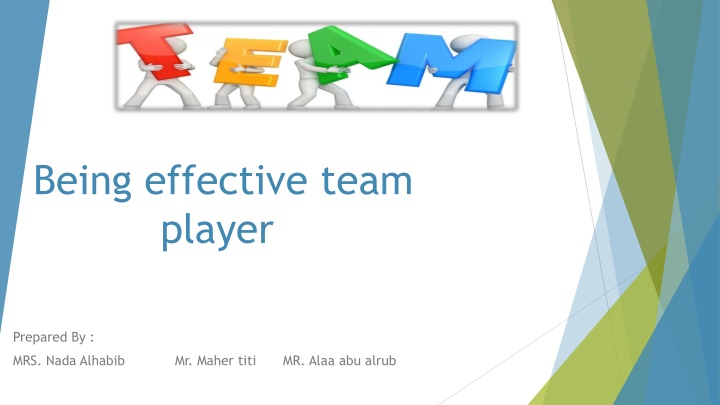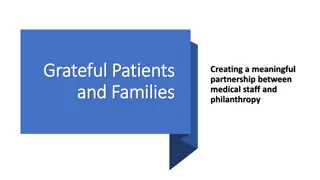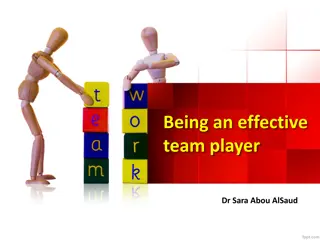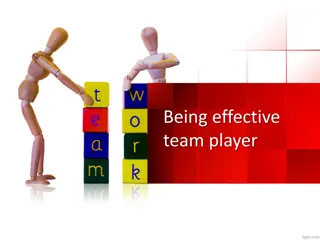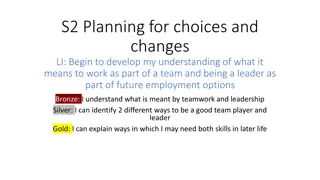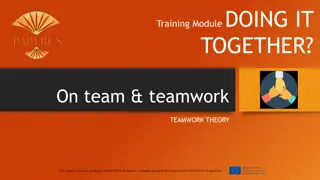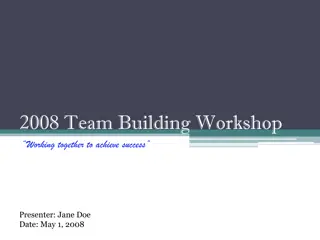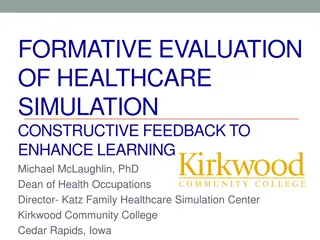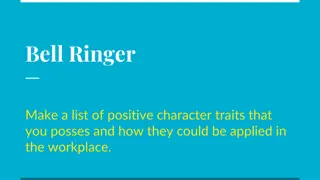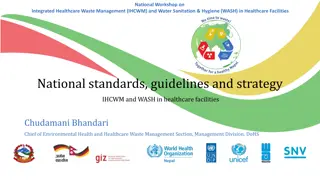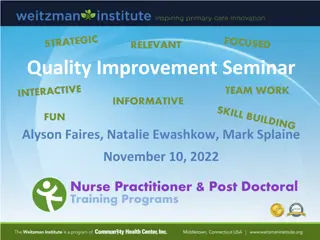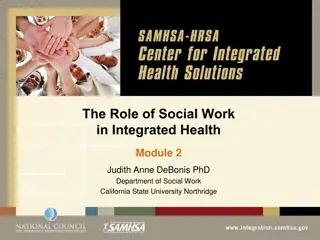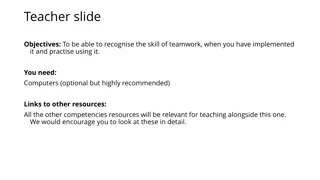Effective Teamwork in Healthcare: Key Concepts and Strategies
Understanding the significance of teamwork in healthcare is vital for promoting patient safety and enhancing overall care quality. This presentation covers the importance of effective team players, various team types and dynamics, stages of team development, successful team assessment, and communication tools for optimizing team performance. It emphasizes the critical role of teamwork in managing complex cases, increasing chronic disease incidences, addressing workforce shortages, and promoting safe working environments.
Download Presentation

Please find below an Image/Link to download the presentation.
The content on the website is provided AS IS for your information and personal use only. It may not be sold, licensed, or shared on other websites without obtaining consent from the author.If you encounter any issues during the download, it is possible that the publisher has removed the file from their server.
You are allowed to download the files provided on this website for personal or commercial use, subject to the condition that they are used lawfully. All files are the property of their respective owners.
The content on the website is provided AS IS for your information and personal use only. It may not be sold, licensed, or shared on other websites without obtaining consent from the author.
E N D
Presentation Transcript
Being effective team player Prepared By : MRS. Nada Alhabib Mr. Maher titi MR. Alaa abu alrub
Objective : Understand the importance of teamwork in health care; Know how to be an effective team player; Identify teams type and nature; Differentiate between the stages of team development; Assess the successful teams; Utilize different tools to promote communication and the performance of the team
Successful Outcome Using Team Techniques https://www.youtube.com/watch?v=yWd56QVL1VQ
Why teamwork is an essential element of patient safety?
Why teamwork is an essential element of patient safety? The importance of effective teams in health care is increasing due to factors such as : The increased incidence of complexity and specialization of care Example :a pregnant woman with diabetes who develops a pulmonary embolus The health-care team might include nurses, a midwife, an obstetrician, an endocrinologist and a respiratory physician, as well as the patient Increasing co-morbidities; Increasing incidence chronic disease; Global workforce shortages Initiatives for safe working hours
What is a team? A team is a group of two or more individuals (have limited lifespan of membership) who: Interact dynamically Have a common goal/objective/mission Have been assigned for specific tasks Possess specialized and complementary skill
What is a team? The team might be : Multidisciplinary team (OR team), VS Intact team ( same discipline e,g IV team) Single owner VS different owner Fixed team, (A constant set of members) VS Fluid team (the memberships may change frequently) Temporary teams VS Permanent teams (human resources team, operation team) Physical Team VS Virtual team
Teams found in health care: Coordinating Team Core teams Ancillary services Contingency teams Support services Administration
Core teams Core teams consist of team leaders and members who are directly involved in caring for the patient Include direct care providers such as nurses, pharmacists, doctors, dentists, assistants and, of course, the patient .
Coordinating teams Is the group responsible for day-to-day operational management, coordination functions and resource management for core teams. Nurses often fill such coordinating
Contingency teams Contingency teams are formed for emergent or specific events (e.g. cardiac arrest teams disaster response teams, rapid response teams).
Ancillary services Ancillary service teams consist of individuals who provide direct, task-specific, time-limited care to patients or support services that facilitate patient care. Such as cleaners staff
Support services Support services teams consist of individuals who provide indirect, task-specific services in a health-care facility. Such as Transportation team, security team
Administration Administration includes the executive leadership of a unit or facility and has 24- hour accountability for the overall function and management of the organization.
Stages of team development https://www.youtube.com/watch?v=D3petxmsfSg
Stages of team building Forming Stage : 1. Initial stage when the team is formed and the members are coming together for the first time. 2. A best candidate should be selected to form a dynamic team , but a flexibility should be adopted in selection process. 3. The skills of the members should match the team task and goals. 4. Voluntary team membership seems to work best when given as a choice.
Stages of team building Storming Stage : 1.Each member tend to rely on his/her own experience. 2.Resistance to work together openly . 3.Hesitate to express new ideas and opinions. 4.Interpersonal disagreement and conflicts. 5.Personal goals rather than team goal .
Stages of team building Norming Stage : 1.Start to know each other. 2.Start to accept each others ideas and opinions. 3.Understand the strengths and weaknesses of the team. 4.Members become friendly to each other. 5.Work together to overcome personal disagreement . 6.Share responsibilities and help each other.
Stages of team building Performing Stage: 1.Member are satisfied with the team progress. 2.Members are capable to deal with any task based on their strength and weaknesses . 3.Work together to achieve the team goals.
How to move from storming to norming stage Team members should be introduce to each other in more details. Responsibilities must be assigned accordingly. Clear communication. Social activities. Role should be in rotation. Everyone should be treated equally.
How the use of the team improves patient care Organizational benefits Reduced hospitalization time and costs of Reduced unanticipated admissions Better accessibility for patients Team benefits Patients Team members Improved coordination of care Efficient use of health-care Enhanced satisfaction with care Acceptance of treatment Enhanced job satisfaction Greater role clarity Enhanced communication Improved health outcomes and quality of care Reduced medical errors Enhanced well- being
Characteristics of successful teams Measurable goals Common purpose Mutual respect Effective communicat ion Effective leadership
Effective leadership Teams require effective leadership that set and maintain structures, manage conflict, listen to members and trust and support members. Effective leadership is a key characteristic of an effective team
Effective communication He following strategies can assist team members in sharing information accurately SBAR Situation What is going on with the patient? Background What is the clinical background or context? Assessment What do I think the problem is? Recommendation What would I do to correct it?
Effective communication Call-out: Call-out is a strategy to communicate important or critical information to inform all team members simultaneously during emergent situations. Such as CPR announcement Check-back/read-back Doctor: Give 25 mg Benadryl IV push. Nurse: 25 mg Benadryl IV push? Doctor: That s correct. Video, SBAR: https://www.youtube.com/watch?v=4SdyKnjPG7 8
Common purpose Team members generate a common and clearly defined purpose that includes collective interests and demonstrates shared ownership Measurable goals Teams set goals that are measurable and focused on the team s task.
Good cohesion Cohesive teams have a unique and identifiable team spirit and commitment and have greater longevity as team members want to continue working together Mutual respect Effective teams have members who respect each others talents and beliefs, in addition to their professional contributions
Challenges to effective teamwork Changing settings Changing roles Health-care hierarchies Individualistic nature of health care
Changing roles In many health-care environments there is considerable change and overlap in the roles played by different health-care professionals. Changing settings The nature of health care is changing in many ways, including increased delivery of care for chronic conditions in community care settings and the transfer of many surgical procedures to outpatient centres
Health-care hierarchies Health care is strongly hierarchical in nature, which can be counterproductive to well functioning and effective teams where all members views should be considered Individualistic nature of health care Many health-care professions, such as nursing, dentistry and medicine, are based on the autonomous one-to-one relationship between the provider and patient.
Conclusion The effective teamwork in health-care delivery can have an immediate and positive impact on patient safety The effective teamwork is essential for minimizing adverse events caused by miscommunication, associated with improved and reduced medical errors The teamwork can have benefits for the individual practitioners in the team and the team as a whole, as well as the organization The Characteristics of the effective team are :Common purpose, Measurable goals, Effective leadership( the key element), Effective communication SBAR , Call-out, Check-back are strategies can assist team members in accurately sharing information
